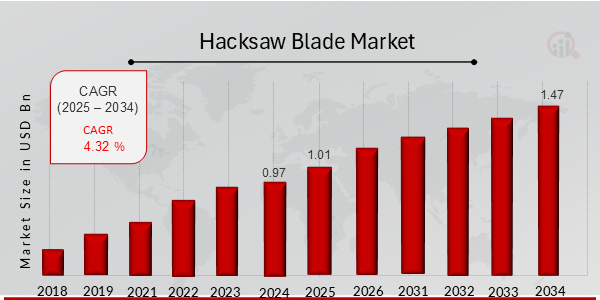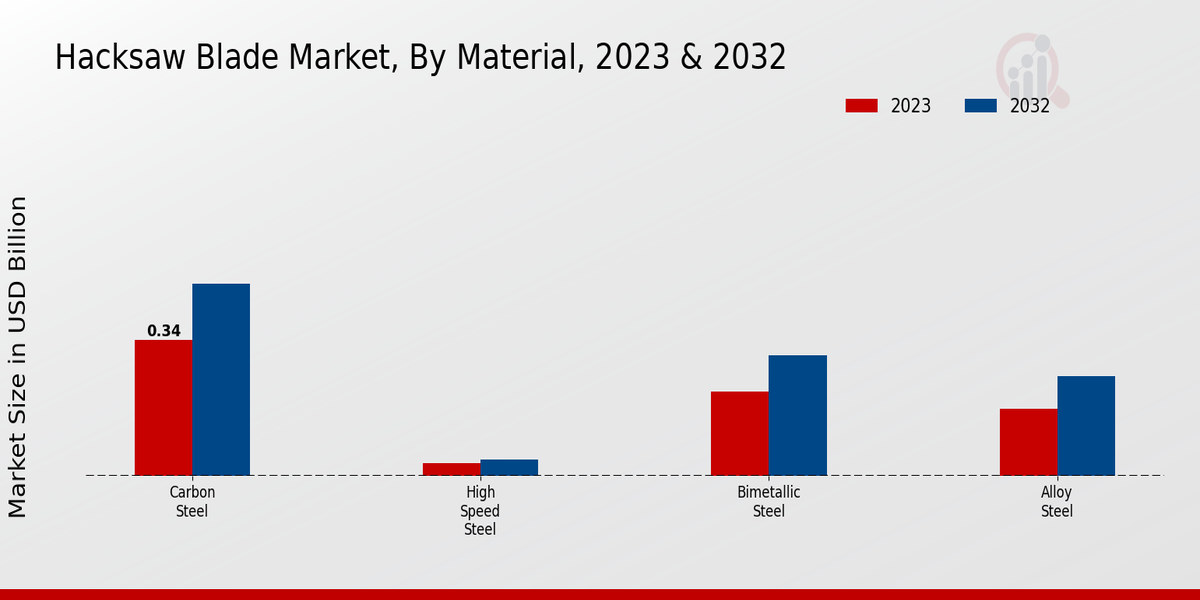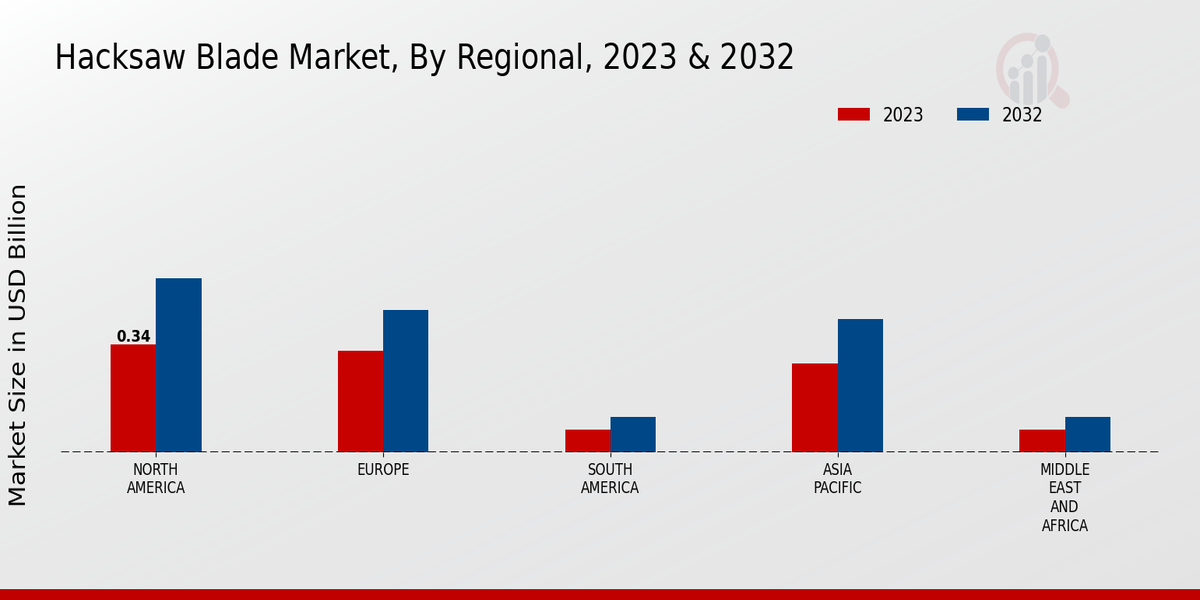Global Hacksaw Blade Market Overview:
As per MRFR analysis, the Hacksaw Blade Market Size was estimated at 0.97 (USD Billion) in 2024. The Hacksaw Blade Market Industry is expected to grow from 1.01 (USD Billion) in 2025 to 1.47 (USD Billion) till 2034, at a CAGR (growth rate) is expected to be around 4.32% during the forecast period (2025 - 2034).
Key Hacksaw Blade Market Trends Highlighted
The hacksaw blade market is driven by the growing demand from various industries, including construction, automotive, and manufacturing. The increasing use of metalworking and fabrication processes is also contributing to the market growth. Additionally, the rising demand for precision cutting tools in industries such as aerospace and electronics is creating opportunities for the market.
Key market drivers include advancements in blade technology, increasing emphasis on productivity, and growing adoption of automated cutting solutions. Opportunities exist in the expansion of emerging markets, the development of new blade materials, and the integration of smart technologies into hacksaw blades. Recent trends in the market include the adoption of high-speed steel blades, the growing popularity of cordless hacksaws, and the increasing use of specialty blades for specific applications.

Source: Primary Research, Secondary Research, MRFR Database and Analyst Review
Hacksaw Blade Market Drivers
Increasing Demand for Metalworking and Construction Activities
The hacksaw blade market is primarily driven by the growing demand for metalworking and construction activities across various industries. Hacksaw blades are essential cutting tools used in metal fabrication, automotive manufacturing, shipbuilding, and construction projects. The rising construction spending and increasing infrastructure development worldwide are expected to fuel the demand for hacksaw blades in the coming years. Moreover, the growing adoption of metalworking processes in industries such as aerospace, automotive, and machinery manufacturing is further contributing to the market growth. The Hacksaw Blade Market Industry is projected to grow significantly in the coming years due to increasing demand from these sectors.
Technological Advancements and Product Innovations
Apart from these factors, technological developments and product innovations are additionally propelling the growth of the hacksaw blade market. Manufacturers are spending heavily on research processes to develop hacksaw blades that are more prompt in performance, strength, and efficiency. Development in blade materials, coatings, and designing have improved its cutting ability and extended its lifespan. Moreover, producers are also investing in producing specific types of hacksaw blades, such as those that can cut hard metals and composite materials, and so will suit the diverse requirements of end-users.
Growth in Emerging Economies and Industrialization
Emerging economies are growing, and higher industrialization in developing countries is the key factor driving the hacksaw blade market. Developing countries are rapidly urbanizing, and the industrialization drive as a result of manufacturing industry development and infrastructural growth is increasing the need for hacksaw blade as earlier stated. In developing countries, governments are coming up with industrial-friendly policies, which, in the long run, will help the market grow.
Hacksaw Blade Market Segment Insights:
Hacksaw Blade Market Material Insights
The market can be divided based on material into carbon steel, HSS, bimetallic steel, alloy steel, and other materials. Carbon steel is the most common hacksaw blade material. It is the cheapest and can cut a broad range of materials, such as wood, metal, and plastic. However, carbon steel is less durable than other materials and goes blunt quicker. HSS is a much more durable material than carbon steel and can be used at higher cutting speeds. As such, it can be used to cut hard metals, such as stainless and tool steel. However, HSS is more expensive than carbon steel.
Bimetallic steel saws are made from a combination of carbon steel and HSS. They are more durable than carbon steel saws but cheaper than HSS saws. Alloy steel blades can be produced from a wide range of alloying elements, such as chromium, vanadium, and molybdenum. They are tougher and more durable than the previously mentioned materials and can be used to cut materials such as armor plates and hardened steel. Similar to HSS blades, however, they are more expensive than carbon steel. Other less common materials for hacksaw blades include tungsten carbide and diamond. Tungsten carbide is one of the hardest materials available and is very tough and durable. It can cut very tough materials, such as ceramics. Diamond is the hardest material available. Diamond-tipped blades can be used to cut any known material. However, both diamond and tungsten carbide blades are very expensive. The choice of material depends on what materials will be cut. For general-purpose cutting, carbon steel blades are adequate. For cutting hard materials, such as metal, HSS or bimetallic steel blades are required. For cutting very hard materials, such as matresses, alloy steel, tungsten carbide, or diamond blades are required.

Source: Primary Research, Secondary Research, MRFR Database and Analyst Review
Hacksaw Blade Market Tooth Pattern Insights
The Hacksaw Blade Market is segmented by tooth pattern into Regular Tooth, Skip Tooth, Double Tooth, Triple Tooth, and Variable Pitch Tooth. The Regular Tooth segment is expected to account for the largest Hacksaw Blade Market revenue share in 2023 due to its wide applicability in various industries. The Skip Tooth segment is projected to exhibit a significant CAGR during the forecast period, owing to its ability to provide faster and smoother cutting. Double Tooth blades are commonly used for cutting thick and hard materials and are anticipated to witness steady growth. Triple Tooth blades are designed for cutting thin and delicate materials and are expected to gain traction in specialized applications. Variable Pitch Tooth blades offer a combination of cutting speeds and finishes, making them suitable for a range of applications.
Hacksaw Blade Market Blade Length Insights
The Hacksaw Blade Market is segmented based on Blade Length into Less than 6 Inches, 6 to 12 Inches, 12 to 18 Inches, 18 to 24 Inches, and 24 Inches and Above. The 6 to 12 Inches segment held the largest market share in 2023 and is projected to continue its dominance throughout the forecast period. This segment is primarily driven by the extensive usage of hacksaw blades in metalworking applications such as cutting pipes, rods, and sheets. The 12 to 18 Inches segment is expected to witness significant growth over the forecast period due to the increasing demand for larger hacksaw blades for heavy-duty cutting applications.
Hacksaw Blade Market Application Insights
The hacksaw blade market is segmented based on application into metal cutting, wood cutting, plastic cutting, ceramic cutting, and other applications. Among these, the metal cutting segment is expected to hold the largest market share in 2023. The growth of this segment can be attributed to the increasing demand for hacksaw blades in metalworking industries. The wood cutting segment is expected to witness significant growth during the forecast period due to the rising demand for hacksaw blades in the construction and woodworking industries. The plastic cutting segment is also expected to grow at a steady pace during the forecast period due to the increasing use of hacksaw blades in the plastic processing industry. The ceramic cutting segment is expected to experience moderate growth during the forecast period due to the increasing demand for hacksaw blades in the ceramic industry. The other applications segment is expected to grow at a steady pace during the forecast period due to the increasing demand for hacksaw blades in various other applications, such as DIY projects and hobbyists.
Hacksaw Blade Market Regional Insights
The Hacksaw Blade Market segmentation by region encompasses North America, Europe, APAC, South America, and MEA. North America holds a significant market share due to the presence of major construction and manufacturing industries. Europe follows closely, driven by growing demand from the automotive and aerospace sectors. APAC is projected to witness substantial growth over the forecast period due to rapid industrialization and infrastructure development, particularly in China and India. South America and MEA represent emerging markets with potential for future growth as urbanization and construction activities increase. The Hacksaw Blade Market is expected to reach a valuation of 0.96 billion USD by 2024, expanding at a CAGR of 4.6% during the forecast period.

Source: Primary Research, Secondary Research, MRFR Database and Analyst Review
Hacksaw Blade Market Key Players And Competitive Insights:
Major players in the Hacksaw Blade Market are constantly innovating and developing new products. They also focus on increasing the number of distribution networks and becoming a bigger part of the market. Leading Hacksaw Blade Market players invest in research and development of better products. They also work in the development of new marketing strategies. The development of the Hacksaw Blade Market is driven by the increasing number of use cases in various industries. The growth of the industry is also spurred by a growing number of DIY projects. Hacksaw Blade Market Competitive Landscape is expected to remain the same in the years to come. Most major players will invest in developing new products either by improving the quality of existing ones or inventing something new.
Stanley Black Decker is one of the major Hacksaw Blade Market players with a large number of products to offer. The company offers its customers hacksaw blades for various applications. They include products for cutting metal, wood, and plastic. Stanley Black Decker also has a number of accessories to offer, such as hacksaw handles, blades, and carrying cases. The company has an extensive distribution network and uses various channels to sell its products. These include hardware and home centers, as well as online stores. And the company can be proud of its premium products and cultivate trust in its customers.
Hacksaw Blade Market leader Bosch has a large variety of products available for their clients. These are used for cutting metal, wood, and plastic. Just like the previous company, Bosch also offers their customers various accessories such as hacksaw handles, blades and carrying cases. Same as in the case of Stanley Black Decker, Bosch has a large distribution network and uses different ways to sell their products. They are present at hardware and home centers and online stores. The company is a source of innovative products and outstanding customer service.
Key Companies in the Hacksaw Blade Market Include:
- Ridgid
- Bahco
- Amana Tool
- Freud
- Makita
- Klein Tools
- Tenryu
- Stanley Black Decker
- Bosch Power Tools
- Irwin Industrial Tools
- CMT Orange
- Milwaukee Electric Tool
- Lenox
- Diablo
- DeWalt
Hacksaw Blade Market Industry Developments
The Hacksaw Blade market is projected to reach USD 1.47 billion by 2034, exhibiting a CAGR of 4.32% during the forecast period (2025-2034). The market growth is attributed to the increasing demand for hacksaw blades in various industrial applications, including metalworking, construction, and automotive. The rising construction activities, particularly in developing economies, are expected to drive the market demand. Additionally, the growing adoption of advanced materials and technologies in hacksaw blade manufacturing is anticipated to enhance product performance and durability, further contributing to market growth. Recent developments in the market include the introduction of high-performance hacksaw blades with extended lifespan and improved cutting efficiency. Key players in the market are focusing on strategic partnerships and collaborations to expand their product offerings and geographic reach.
Hacksaw Blade Market Segmentation Insights
-
Hacksaw Blade Market Material Outlook
- Carbon Steel
- High Speed Steel
- Bimetallic Steel
- Alloy Steel
- Other Materials
-
Hacksaw Blade Market Tooth Pattern Outlook
- Regular Tooth
- Skip Tooth
- Double Tooth
- Triple Tooth
- Variable Pitch Tooth
-
Hacksaw Blade Market Blade Length Outlook
- Less than 6 Inches
- 6 to 12 Inches
- 12 to 18 Inches
- 18 to 24 Inches
- 24 Inches and Above
-
Hacksaw Blade Market Application Outlook
- Metal Cutting
- Wood Cutting
- Plastic Cutting
- Ceramic Cutting
- Other Applications
-
Hacksaw Blade Market Regional Outlook
- North America
- Europe
- South America
- Asia Pacific
- Middle East and Africa
| Report Attribute/Metric |
Details |
|
Market Size 2024
|
0.97 (USD Billion)
|
|
Market Size 2025
|
1.01 (USD Billion)
|
|
Market Size 2034
|
1.47 (USD Billion)
|
|
Compound Annual Growth Rate (CAGR)
|
4.32% (2025 - 2034)
|
|
Report Coverage
|
Revenue Forecast, Competitive Landscape, Growth Factors, and Trends
|
|
Base Year
|
2024
|
|
Market Forecast Period
|
2025 - 2034
|
|
Historical Data
|
2019 - 2023
|
| Market Forecast Units |
USD Billion |
| Key Companies Profiled |
Ridgid, Bahco, Amana Tool, Freud, Makita, Klein Tools, Tenryu, Stanley Black Decker, Bosch Power Tools, Irwin Industrial Tools, CMT Orange, Milwaukee Electric Tool, Lenox, Diablo, DeWalt |
| Segments Covered |
Material, Tooth Pattern, Blade Length, Application, Regional |
| Key Market Opportunities |
Growth in the construction industry Rising demand for metalworking tools Advancements in manufacturing technology Increasing popularity of DIY projects Expansion in the automotive sector |
| Key Market Dynamics |
Rising demand Technological advancements Growing construction sector Increasing disposable income Expanding manufacturing industry |
| Countries Covered |
North America, Europe, APAC, South America, MEA |
Frequently Asked Questions (FAQ) :
The Hacksaw Blade Market is expected to reach a valuation of 1.01 Billion USD in 2025.
The Hacksaw Blade Market is expected to reach a valuation of 1.47 Billion USD by 2034.
The Hacksaw Blade Market is expected to grow at a CAGR of 4.32% from 2025 to 2034.
North America is expected to hold the largest market share in the Hacksaw Blade Market in 2032.
The metalworking segment is expected to hold the largest market share in the Hacksaw Blade Market in 2032.
Some of the key competitors in the Hacksaw Blade Market include Stanley Black Decker, Robert Bosch GmbH, and Irwin Industrial Tools.
Major factors driving the growth of the Hacksaw Blade Market include increasing demand from the construction and automotive industries.
Major challenges faced by the Hacksaw Blade Market include competition from alternative cutting tools and fluctuations in raw material prices.
Key trends expected to shape the future of the Hacksaw Blade Market include the adoption of advanced materials and the development of innovative blade designs.
Key opportunities for growth in the Hacksaw Blade Market include expanding into emerging markets and developing new applications for hacksaw blades.

















